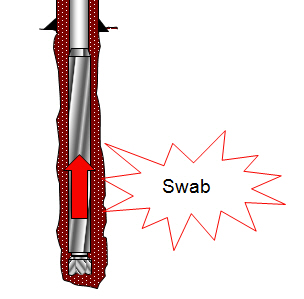I would like to show more calculation about surge and swab pressure. In this article, I will show how to use the previous formulas (Surge and swab pressure method 1) to figure out surge and swab pressure for close-ended pipe (plug flow). The calculation concept is pretty much the same but I would like to show you how much difference between surge/swab if you have the close-ended pipe.
I still use the same data but this time so I can compare apple to apple with the previous calculation.
Example
The well information is listed below:
θ300 = 85
θ600 = 130
Hole diameter = 9 inch
Drill Collar = 6.25 inch
ID of drill collar = 2.5 inch
Drillpipe diameter = 5 inch
ID of drill pipe = 3.5 inch
Average pipe running or pulling speed = 250 ft/min
Drill Pipe Length = 12000 ft
Drill Collar Length = 800 ft
Current Mud Weight = 12.5 ppg
Well TVD = 9000 ft
2nd case – closed ended pipe
Determine pressure loss around drill pipe
1. Determine n
![]()
n= 0.613
2. Determine K
![]()
K=1.863
3. Determine fluid velocity around drill pipe
For closed ended pipe

Vdp = 224.1 ft/min
4. Maximum pipe velocity
Vm = 224.1 x 1.5 = 336 ft/min
5. Pressure loss around drill pipe

Pdp =540.7 psi
Determine pressure loss around drill collar
We still use the same n and K.
1. Determine fluid velocity around drill collar
For open ended pipe
![]()
Vdc = 345.4 ft/min
2. Maximum pipe velocity
Vm = 345.4 x 1.5 = 518 ft/min
3. Pressure loss around drill collar

Pdc = 86 psi
Total pressure loss = Pdp + Pdc
Total pressure loss = 540.7 + 86 = 626.7 psi
Determine surge pressure with the following equation.

Surge pressure = hydrostatic pressure + total pressure loss
Surge pressure = (0.052 x 9000 x 12.5) + 626.7 = 6,476.6 psi
Determine swab pressure with the following equation.

Swab pressure = hydrostatic pressure – total pressure loss
Swab pressure = (0.052 x 9000 x 12.5) – 626.7 = 5,223.3 psi
When compared with 1st case (surge and swab pressure for open-ended pipe), you can see that the closed ended pipe creates more surge and swab effect.














What is swabbing and how does it help unload the liquids with minimal energy instead of manual unloading or free venting?
ReplyDelete